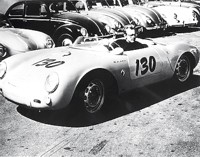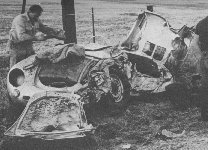 |
deathofjamesdean.com | |||||
| Symposium |
| About Us |
| Maps |
| 9/30/55 |
| Rolf Wutherich |
| The Spyder |
| Death Drive |
| Cholame |
| Donald Turnupseed |
| Annabele (Kay) Coombe |
| Bobby Joe Plant |
| News |
| Guest Book |
1955 Porsche Spyder |
||
Death Car Mystique by Warren Beath Ghosts and cursed cars have been a wonderful by-product of the James Dean legend. Mikita Brottman in her introduction to the collection of articles called Car Crash Culture calls Dean’s death “The mother of all celebrity car crashes” and asks “Is it possible that the highly charged panic and emotion of a violent death can stay with the parts of a wrecked car? Can accident sites somehow retain the ghosts, the memories, the smells of an accident? This common superstition is the basis of ‘The Death Car,’ on of the many urban legends involving automobiles….” (Brottman p. xix)
In December, 1957 Whisper magazine printed a story "Ghost Driver of Polonio Pass" by Sam Schaeffer that vividly described the phantom Porsche that appeared in the fog in the vicinity of the intersection where Dean had met his highway demise.
*A mechanic unloading the wreckage from a truck has both legs broken when the hulk falls on him. *The engine is sold to Dr. Troy McHenry who is killed in a car powered by Dean's motor. *Dr. William Eschrich's car rolls over in the same race. The car has Dean's drive train. *A sports car driver buys the Spyder's heavy duty racing tires and both of them blow out simultaneously, almost killing him. (The tires were among the few authentic artifacts of Dean's car in the welded-together mess that toured the country under Barris' banner.) *The Highway Patrol garage fire story was recounted. *A month later the car falls off steel display mountings and breaks the hip of a teenager. *A few weeks later the car is on a truck carrying to to Salinas when it falls off the truck and crushes the driver who had been thrown from the truck-- don't ask me how. *The car breaks mysteriously into two pieces and causes a traffic accident. *In Oregon, the car is on a truck when the truck's emergency brake slips and sends the truck smashing into a store. *In New Orleans the car breaks spontaneously into 11 pieces while resting on stationary supports. *The car disappears off a freight truck. *Rolf Wuetherich is convicted of murdering his wife.
The most famous race car that never raced. Little Bastard's engine Specifications: Engine: Ernst Furhmann 547 Type: Four-Overhead-Cam flat four-cylinder with horizontally opposed pistons. Dispacement: 1498cc 90 brake horsepower @ 6200 RPMs, 125-135 peak horsepower @ 8,000 RPMs Gearbox: 5-speed manual Chassis: Tubular with torsion-bar suspension Top speed: 150 miles per hour Dean and the "Little Bastard" at Competition Motors, ready to leave for Salinas September 30, 1955.
By Tim Black On September 18, 1955, Dean bought his Porsche 550 Spyder here. Back then the building was called Competition Motors and it was owned by Johnny Von Neumann. The building was replaced by a church addition in 2005. He was still in production at Warners on Giant and brought the Spyder on the Warner's lot for his final "Last Supper" scene on the 24th. Legend has Jack Warner telling him not to drive it on the lot again. He personalized it with the words "Little Bastard" on the lower rear part of the engine cover. In a 1983 interview, Bill Hickman told Warren Beath this was what he called Dean, and Dean called him "Big Bastard" and that was the inspiration for Dean naming the car. There are many other versions of the story behind the name. The actual reason Jimmy named the car "Little Bastard" will remain muddled in argument and theory forever. Jimmy's Spyder's was built in Stuttgart in July, 1955.There were perhaps many reasons Jimmy decided to purchase the car. Some may submit that it was because he felt the need to become more competitive since he had pushed his 356 Speedster to the limit a few months earlier and blew the engine. To understand his reason for buying it is to understand the psychology behind his life-long competitive nature, and that story is covered in Warren's "Psychological Autopsy of James Dean" article which may appear on a future page. But it is safe to say that the 550 Spyder was a vast departure from the 356 Super Speedster he drove at the Palm Springs, Bakersfield, and Santa Barbara races months earlier, before a contract with Warners kept him from racing during the filming of Giant. That contract was timed well, because his Speedster was being repaired by Johnny Von Neumann's award-winning mechanic Rolf Wuetherich, back at Competition Motors after Dean blew the engine at the May 28th Santa Barbara race. This gave Wuetherich the needed time to repair Jimmy's 356 correctly and to smooth out other damages to the car Jimmy created as a novice auto racer, hell-bent on winning, despite his limited professional racecar driving experience. Dean soon left for Marfa, Texas, to film scenes for Giant, and his racing activities were on hold for the summer of '55. He would have no way of knowing, as he dusted off his cowboy hat for George Stevens in a Texas exterior shot, that his "dream car" and "death car" was being created five-thousand miles away in a Stuttgart car plant. One can wonder why Jimmy, who was notorious for being tight about money, would spend $7,000 on the 550 Spyder. You can study his thought processes based on the Psychological Autopsy, however it also brings up the point: "Was the 550 worth the cost?" Porsche's First Official Race Car: The Porsche 550 Spyder Model 1500RS Introduced in 1953, the sensational 550 Spyder was Porsche's first official race car and would win its class in famous Europen races including the Mille Miglia in Italy and the Lemans 24-hour race in France competing against top sports-racing cars. It also got a class win in the Carrera Panamericana race that ran the length of Mexico on appalling roads in extreme temperatures. It was an earlier class victory in the Mille Miglia with Lurani-Berckheim, that convinced Ferry Porsche to create a racing division where he could set up more and more competitive engines and cars to win that race and many others. The decision to use the name "Spyder" was made at the request of Max Hoffman who was Porsche's influential U.S. importer. He knew that the name would be more marketable than a number such as "550/1500RS" the name Porsche planned to call the car. In Europe, "Spyder" was the description for a light-weight, two-seat, competition sportscar. The 550 Spyder typically cost $6800 in U.S. dollars in 1955 when a full-dress convertible Cadillac only cost $4448.00 The 550 was powered by a four-overhead-cam flat four-cylinder with horizontally opposed pistons. It was a 1498cc engine developing 125-135 horsepower coupled to a five-speed manual gearbox. The chassis had a torsion-bar suspension and weighed 1120 lbs. It had a top speed of 150 miles an hour. The Fuhrmann engine-transmisssion unit was designated the "547" and was known for the vertical drive of its camshafts, its dual plug ignition, roller bearings, and double-sided cooling fan. Some insiders called it the "Schubladenmotor", or "drawer engine". The young engineer who invented it, Ernst Fuhrmann, received his doctorate with this complicated engine design. It is known for its difficulty to service by anyone but a handful of extremely well-trained German mechanics. This is why Rolf Wuetherich, Jimmy's mechanic, was the only person Jimmy would allow to touch the engine of his "baby". Porsche did not want to sell these cars unless they were being raced to win. This is probably the reason Rolf Wuetherich convinced a reluctant Johnny Von Neumann to sell the car to Dean, and offered to accompany Dean to every race. Rolf was an extremely well-trained Stuttgart racing mechanic and driver. The 550 was the pride of the Stuttgart Crest and tons of that pride had been absorbed into their new racer. Dean was a rising star and Hollywood was good exposure for the marketing of these cars. However Dean was a novice racer compared to the model racer Ferry Porsche had in mind when he set out to compete in the European races of the day. In 1953, inspired by the success of the Porsche-based Glockler specials of the early Nineteen-Fifties, Porsche set out to construct the firm's first proper race car. Jimmy's first Porsche, the 356 Super Speedster, was basically a highly modified Volkswagen. It had proven only moderately successful as a racer. Dean found that out when he pushed his too hard trying to win at Santa Barbara Memorial Day weekend 1955. If Porsche was going to compete against cars like Jaguar, Aston Martin, Bristol (forerunner of the Shelby Cobra), MG and Triumph, it was going to need a whole new car. Despite the limited funds available to them that lean year 1953, two separate programs were initiated at the factory. Ernst Fuhrmann was in charge of designing a competition engine dubbed "project 547" and Wilhelm Hild headed the development of a new chassis called "Project 550". There were only a few months available for Hild's team to construct the new racer for its scheduled debut at the 1953 24-hour Lemans race in France. The design was similar to the mid-engined Glockler, which was equipped with a modified 356 drivetrain reversed with the engine between the driver and the rear axle. A simple tube-ladder frame was created with six cross-members. The front and rear suspension were similar to production Porsches with only small revisions to handle the expected higher load.
Glockler; a forerunner to the 550 Spyder at an early 1952 race The brakes and wheels were borrowed from the 356 parts bins. Two chassis were constructed, but with Furhmann not yet ready with his 547 engine, a 356 1500 Super engine was fitted into the chassis for testing purposes. Close to 100 brake horsepower could be produced by the 356 engine, running at a very high compression, when fueled by alcohol. For the 550, a compression ratio of 9.0:1 was chosen for reliability reasons, which was still enough for 78bhp. Equipped with a roadster body, the first 550 debuted in the Effel Races at the Nurburgring. Although troubled by bad weather and a bad carburetor, Helm Glockler drove Porsche's racing car to a debut victory, despite strong opposition from EMW and Borgward. Porsche continued to enter two cars at Lemans. The Nurburgring winner was fitted with a coupe body that was expected to be better suited to the high speed track. The 1100cc to 1500cc class was easily beaten without really stressing the cars much and at the end, both racers had covered an identicle distance and finished 15th and 16th overall. The class victory was awarded to Richard Frankenberg and Paul Frere driving a 550-02. After the Lemans race, the cars were raced twice in German events with Hans Herrmann scoring another win in the 550-02. In the meantime, Ernst Furhmann was still hard at work.
Ready To Take On The World Stage The Ernst Furhmann 547 Engine has landed Not everyone was supposed to know about the engine while it was under construction. Some parts were made "under the work bench", so to speak. When certain "guests" came, the parts were hidden in drawers-thus the name "Schubladenmotor". Ernst Furhmann would eventually become Porsche AG's Chairman of the Board in 1976 as the result of the 547 engine, also the forerunner of all the Carrera engines of modern Porsches. The 547 engine was built from 1953 to 1965. The 547 is among the most precision-made engines in the world even today. Every little screw is highly polished. Since Furmann was told to stay within the 1500cc limit and to get the most out of the small displacement, he felt overhead camshafts were necessary. Compared to the overhead valve engine of 356 road cars, the new 547 had a larger bore and shorter stroke to displace 1498cc. Each set of two cylinders was equipped with two overhead camshafts, driven by shafts instead of the more traditional chains or belts. A similar design was used for the flat-12 engine Furhmann had previously designed for the Cisitalia Grand Prix engine. The original Fuhrmann engine was first tested on a Zuffenhausen test station on April 2, 1953. Made for racing, it generated 110 horsepower at 6200 rpms. It was installed in the new Porsche racing car, the 550 Spyder. With this car and engine, Hans Herrmann took third place in overall rankings for the 1954 Carrera Panamericana. Since then, the name Carrera has played a prominent part in the history of all Porsche models. Porsche used the Paris Motorshow to showcase Furhmann's new engine and to announce the production of the 550 RS Spyder. It would be available in 1954 as a race-ready car for very limited customers. The show car was the fifth constructed and featured various amenities like a full-width windshield complete with wipers. a lockable glove compartment, two seats, and a convertible top. Before the 550 was deemed production-ready, many more minor modifications to the engine and chassis were made. Back on the track, the 547 engine showed potential, but the peaky power delivery required some work to fine-tune. Meanwhile, the two coupes were prepared for the Carerra Panamericana race for two South American customers. Complete with bright sponsor stickers, they again dominated the 1500cc class. Jaroslav Juhan's 550-01 was the faster of the two, but his retirement left the victory for Jose Herrarte's 550-02. A year later the quad-cam 550 Spyder (550-04) matched Herrarte's class winning performance and placed third overall. Soon after, the "Carerra" name was adopted for the 356 models equipped with the Fuhrmann engine. Although the 550 Spyder had been announced as a production model in late 1953, many customers had pre-ordered them. As a result, Porsche spent most of '54 finalizing cars to customer specifications. Meanwhile, on the track, there was little stopping the agile racer. At the end of the production, cars finally became available turning many privateers into race winners. A race-ready 1954 550 James Dean and the 550; a brief encounter In 1955, Porsche decided to install this air-cooled racing engine in the standard 356 as well. The first Carerra had 110 horsepower. By 1955, Jimmy's car would have 110 horsepower. James Dean was 24 years-old when he bought his 550 Spyder. He would have been a hard-driving competitor had he made it to Salinas that weekend, but the 550 was a completely different car and much less forgiving around the curves than his low-center-of -gravity 356 Super Speedster. One may develop the image he may have been killed at the race track in Salinas, giving him one more day to live. In the week prior to the race, the evidence Dean was a driving novice as far as the Spyder was concerned, revealed itself in the form of a busted left front signal lense and a sizable dent on the right-rear fender. There is evidence of some minor "fender-benders" in those photos Sanford Roth took at Competition Motors while the "Little Bastard" was being prepped for the race at the Salinas airport.
James Dean only had his 550 Spyder a few days before he would drive it to his death. Car customizer of Batman and The Munsters fame, George Barris, eventually bought the wrecked body and tried unsuccessfully to fix it before he lost interest in the futile attempt and began loaning it out for traffic safety displays. The body disappeared from the public eye in 1960 under mysterious circumstances, although it was most likely the victim of the car crusher. By that time the body had been in so many transport and storage accidents, and had been picked apart so badly, it was a mass of junk aluminum and the rebirth of the James Dean craze was years away. The other precision engine and suspension parts were sold as well and still exist under the watchful and selfish eyes of the owner. tb
|
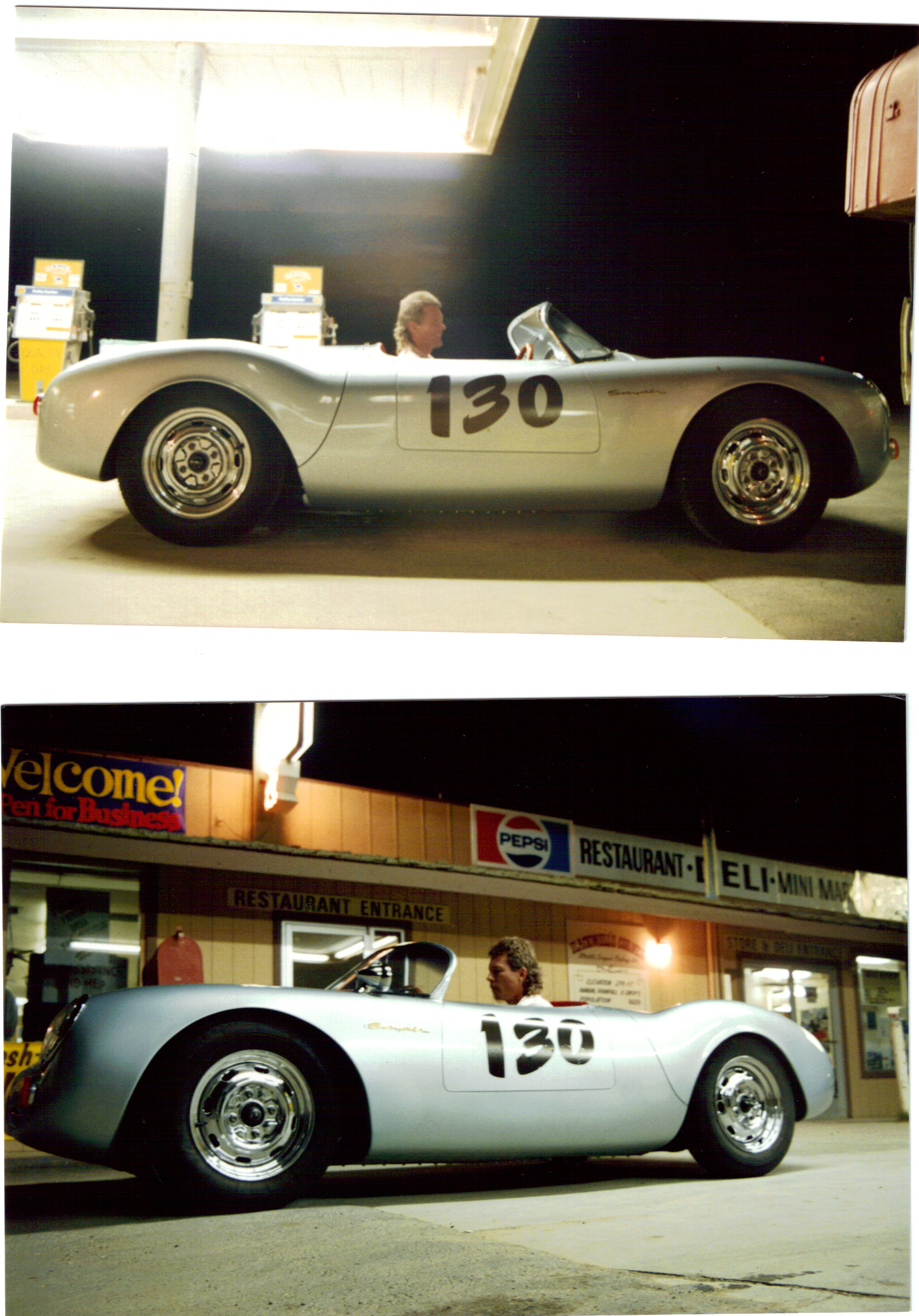 |
|---|
Author Warren Beath (and his Mullet) in a 1955 Porsch Spyder replica.
|
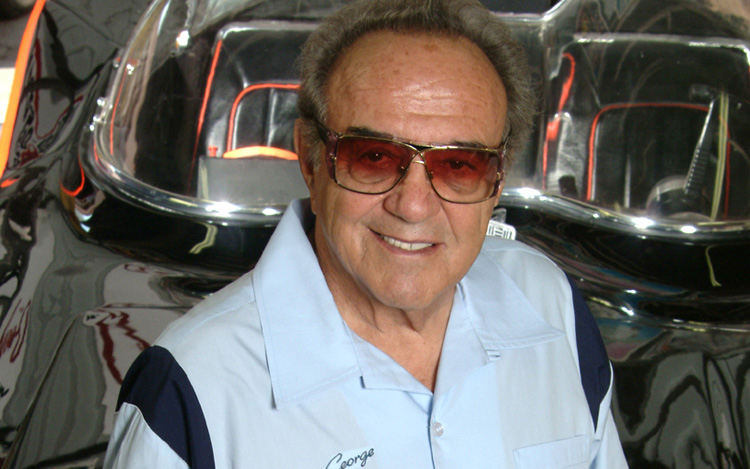
George Barris
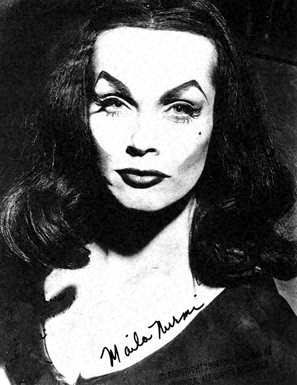
Maila Nurmi

Dean's wrecked Porsche Spyder was used in a Public Saftey Campaign after his Death.
